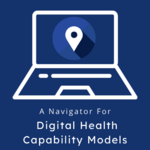Navigator for Digital Health Capability Models: Difference between revisions
mNo edit summary |
No edit summary |
||
| Line 4: | Line 4: | ||
The Navigator for Digital Health Capability Models (also called the 'Navigator') enables health systems planners, implementors, evaluators, and funders to understand the value of using maturity model-based tools, identify and use the most appropriate tool(s), and leverage past maturity model-based assessments to improve digital health capabilities at the national and sub-national levels. | The Navigator for Digital Health Capability Models (also called the 'Navigator') enables health systems planners, implementors, evaluators, and funders to understand the value of using maturity model-based tools, identify and use the most appropriate tool(s), and leverage past maturity model-based assessments to improve digital health capabilities at the national and sub-national levels. | ||
The Navigator includes the following components: | The Navigator includes the following components: | ||
| Line 18: | Line 17: | ||
The appendix provides an in-depth mapping of indicators between the six maturity model-based tools in the Navigator. | The appendix provides an in-depth mapping of indicators between the six maturity model-based tools in the Navigator. | ||
==== Technical brief: The need for a Digital Health Maturity Model Navigator ==== | |||
An early step in the process of developing the Navigator for Digital Health Capability Models was to interview tool developers, implementors, and country stakeholders to better understand motivations and goals in using maturity model-based tools. This technical brief summarizes those interviews. | |||
The Navigator includes six maturity model-based tools: | The Navigator includes six maturity model-based tools: | ||
| Line 28: | Line 29: | ||
The Navigator was developed by the University of North Carolina at Chapel Hill and Digital Square, with funding and technical advisory support from the United States Agency for International Development (USAID). An advisory team composed of representatives from USAID, the World Health Organization, World Bank, the United Nations Children’s Fund, John Snow, Inc., and the Kati Collective provided input and suggestions. Members of the Digital Health and Interoperability Working Group’s Small Working Group on maturity models provided valuable input and feedback on the various iterations of the Navigator and contributed to the Navigator’s testing. | The Navigator was developed by the University of North Carolina at Chapel Hill and Digital Square, with funding and technical advisory support from the United States Agency for International Development (USAID). An advisory team composed of representatives from USAID, the World Health Organization, World Bank, the United Nations Children’s Fund, Country Health Information Systems and Data Use (CHISU) / John Snow, Inc., and the Kati Collective provided input and suggestions. Members of the Digital Health and Interoperability Working Group’s Small Working Group on maturity models provided valuable input and feedback on the various iterations of the Navigator and contributed to the Navigator’s testing. | ||
Revision as of 16:19, 4 November 2021
The Navigator for Digital Health Capability Models (also called the 'Navigator') enables health systems planners, implementors, evaluators, and funders to understand the value of using maturity model-based tools, identify and use the most appropriate tool(s), and leverage past maturity model-based assessments to improve digital health capabilities at the national and sub-national levels.
The Navigator includes the following components:
This guidance provides an overview on the use of maturity model-based assessment tools; an introduction to the individual tools included in the Navigator; guidance on how to identify the best tool(s) to meet your assessment needs; and details on how to use tools in combination with one another.
The Microsoft Excel workbook helps users:
- Identify and use the most appropriate maturity model-based tool(s).
- Leverage past maturity model-based assessments to inform new or planned assessments.
This Microsoft PowerPoint includes an abridged version of the User’s Guide and can be used for working with groups that may want to use the Excel-based Workbook but need additional information in the form of a presentation.
The appendix provides an in-depth mapping of indicators between the six maturity model-based tools in the Navigator.
An early step in the process of developing the Navigator for Digital Health Capability Models was to interview tool developers, implementors, and country stakeholders to better understand motivations and goals in using maturity model-based tools. This technical brief summarizes those interviews.
The Navigator includes six maturity model-based tools:
- Early-Stage Digital Health Investment Tool (EDIT)
- Global Digital Health Index (GDHI)
- Health Information Systems Interoperability Maturity Toolkit (IMM)
- Information Systems for Health Toolkit (IS4H)
- Survey, Count, Optimize, Review, Enable (SCORE) Essential Interventions
- Health Information System Stages of Continuous Improvement (SOCI) Toolkit
The Navigator was developed by the University of North Carolina at Chapel Hill and Digital Square, with funding and technical advisory support from the United States Agency for International Development (USAID). An advisory team composed of representatives from USAID, the World Health Organization, World Bank, the United Nations Children’s Fund, Country Health Information Systems and Data Use (CHISU) / John Snow, Inc., and the Kati Collective provided input and suggestions. Members of the Digital Health and Interoperability Working Group’s Small Working Group on maturity models provided valuable input and feedback on the various iterations of the Navigator and contributed to the Navigator’s testing.

